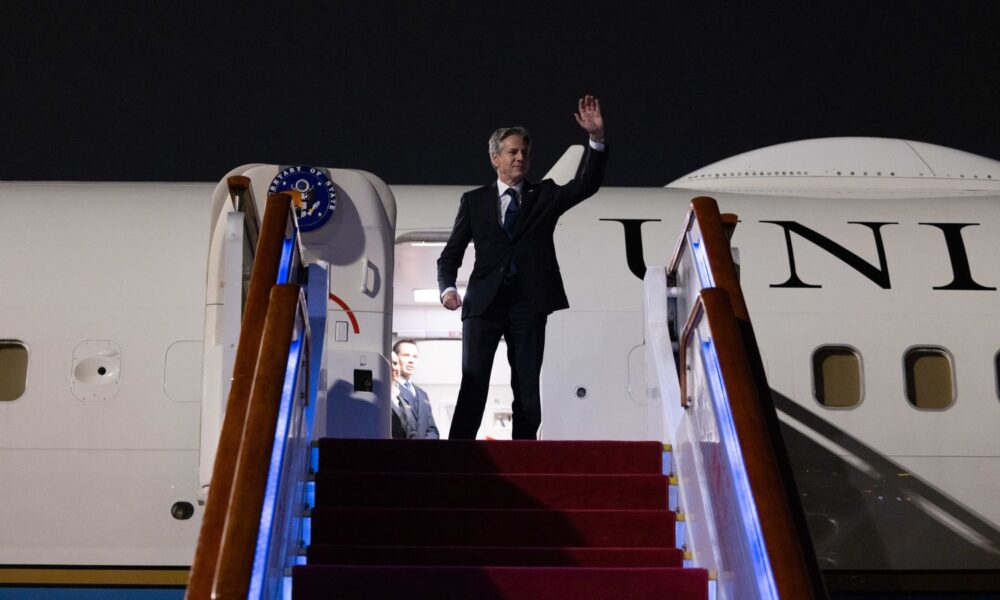Secretary of State Anthony Blinken finally made it to Beijing. His visit, the first of any US Secretary of State since 2018, was initially postponed in February following the Chinese balloon incident.
US and Chinese reactions to Blinken’s brief meeting with President Xi Jinping differ subtly yet significantly. Blinken’s comments and the State Department’s readout characterize the relationship as a competition in need of guardrails and stability. The People’s Daily quoted President Xi Jinping as saying that great-power competition “does not accord with the trend of the times”.
While the visit itself was positive, these diverging reactions clearly show how differently each side views the relationship. If the United States makes no effort to see things from China’s point of view, it risks foregoing potential improvements in bilateral communication and ties.
Tarmac takes and mutual interests
Ahead of Blinken’s visit, there was significant speculation about what his reception in Beijing would be like, both aesthetically and in terms of the agenda. Would President Xi even meet with him? Many commentators and analysts placed a lot of emphasis on appearances, claiming that everything from Blinken’s reception at the airport to the seating arrangements in meetings with the Ministry of Foreign Affairs were designed snubs.
Perhaps, but John Kerry and Hillary Clinton received the same airport welcoming committee. Nervy speculation about aesthetics shows just how necessary a return to consistent face-to-face visits is; without regular communication, pointless speculation can distort the discourse and continue to sour the relationship.
It is significant that Xi decided to meet with Blinken. In their meeting, the two agreed on the need to continue stabilizing relations, with Xi calling for mutual respect and sincerity and Blinken conveying President Biden’s belief that the two have an “obligation and responsibility” to manage their relationship.
The Chinese MFA and State Department readouts are more detailed. They lay bare differing views that make stabilization harder to achieve.
In the Chinese side’s readout, Xi emphasized the importance of both sides’ core interests. He said that great-power competition is incompatible with modern times and cannot solve problems connected to US national interests or challenges facing the international community. Further, he said that China does not seek to challenge or supersede the United States, and asked the United States to give the same respect to China and refrain from impairing its development interests.
Blinken, meanwhile, insisted the foundation of the US-China relationship is competition. The main goal of his visit was to communicate an intent to strengthen US competitiveness but reduce the risk of that competition turning into conflict. He emphasized that diplomacy could only support cooperation in areas “where our interests align”.
A central question for the future of the relationship is what those areas of mutual interest look like. Are they broad, like Xi suggests? Do they include the two countries’ respective economic development and core interests? Or are they restricted to cooperation on international issues like climate change and global health, and limited by the idea that the two countries are locked in a struggle between reshaping and maintaining the global order?
Despite Blinken’s assurances that the United States is still greatly interested in maintaining economic ties (trade hit a record high in 2022), and that recent export controls are about de-risking rather than general decoupling, Beijing is most likely skeptical. As vice president for studies at the Carnegie Endowment for International Peace Evan Feigenbaum pointed out, there are 600 Chinese companies on the Entity List, and the current administration has added 100 of them.
Then again, just like Beijing’s skepticism about de-risking, most people in Washington seem unconvinced that Beijing does not have designs on the United States’ current global leadership position. A constant topic in committee hearings focused on China is how best to counter its efforts to unseat the United States. Practically every action taken by China, domestically or internationally, is analyzed as a move to disrupt US interests.
Room for improvement
There is potential for progress in the bilateral relationship, but only increased high-level communication and more frequent visits can help address issues connected to diverging understandings of what the relationship entails. Thankfully, both sides highlighted the need to do both. Hopefully they will follow through.
Despite differing views on the competition between the two sides, both Xi and Blinken expressed hope to avoid dangerous flare-ups or clashes. Blinken reiterating US adherence to the “One China” policy is positive, but US actions need to match the secretary’s words.
One item on Blinken’s agenda that fell through was the establishment of military-to-military communications. The Chinese refusal to establish such a channel is likely tied to President Biden’s failure to lift sanctions on Chinese Defense Minister Li Shangfu, which were initially placed on him by the Trump administration when he was in charge of procurement.
The United States cannot hope to achieve its desired improvements to this relationship without a willingness to cooperate. Seeming to say one thing and do another not only frustrates China, it also hurts our image in the eyes of other countries.
Secretary Blinken said that he came to Beijing “to explore areas where we might work together when our interests align”; Xi’s comments suggest a Chinese belief that the most important Chinese and US interests, namely peace and steady economic development, are compatible. Here’s hoping that these are not just empty words, but the beginning of a thaw.

